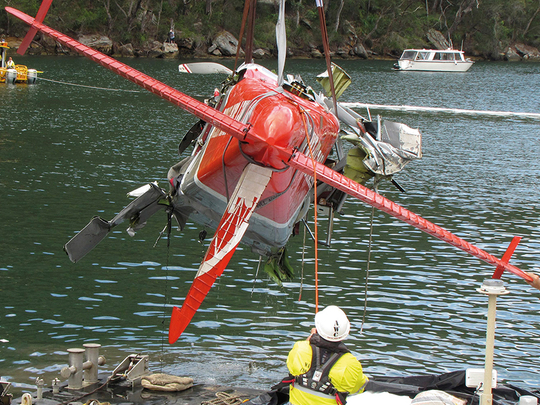
SYDNEY, Australia A seaplane that crashed near Sydney on New Year’s Eve killing five British tourists and the pilot veered significantly off course just before plunging into the water, investigators said Wednesday.
The boss of the company which operated the plane described the pilot’s manoeuvres ahead of the crash as “inexplicable”.
A preliminary report released by the Australian Transport Safety Bureau (ATSB) identified no flight control or structural issues which might have caused the crash.
But the report noted that the accident location was off the standard path for the sightseeing flight.
British chief executive Richard Cousins, his two sons, fiancee and her daughter were killed alongside the pilot in the accident on the Hawkesbury River some 50 kilometres north of Sydney.
Shortly after taking off, witnesses told the ATSB they saw the Sydney Seaplanes aircraft enter Jerusalem Bay outside its flight path at an altitude below the height of the surrounding terrain.
Witnesses said the plane’s engine sounded normal but then they saw the “aircraft suddenly enter a steep right turn and the aircraft’s nose suddenly drop before the aircraft collided with the water in a near vertical position”, according to the report.
The head of Sydney Seaplanes said he was perplexed by the pilot’s turn into Jerusalem Bay “which is surrounded by steep terrain and has no exit”.
“It is not a route we authorise in our landing and take-off register and the plane simply should not have been where it was,” Aaron Shaw, CEO of Sydney Seaplanes, said in a statement.
Shaw said the steep turn, reported to be at an 80-90 degree bank at a low altitude, “by a pilot with Gareth (Morgan)’s skill, experience and intimate knowledge of the location is totally inexplicable”.
Morgan had a total flying experience of more than 10,000 hours, with 9,000 on floatplanes, the ATSB said.
The de Havilland Canada DHC-2 Beaver aircraft was recovered on January 4 after sinking to a depth of 14.5 metres, with ATSB investigators carrying out an initial examination of the wreckage.
They said there was “no evidence of a bird-strike or collision with an object” before take-off or during the flight, and no evidence of an in-flight break-up or pre-impact structural damage.
The examination also found there was flight control continuity throughout, “indicating no evidence of flight control issues”.
The investigation was complicated by the lack of a cockpit voice or flight data recorder — which is not required for such an aircraft — as well as no commercial video recording equipment on the seaplane.
Tests of the fuel used by the plane did not find any quality concerns.
The aircraft, which was manufactured in 1963, had been involved in a fatal accident in 1996 but was later repaired and recertified as airworthy, returning to service in 2000.
A final report by the ATSB is due by the end of the year, with investigators set to conduct further examinations including of the aircraft’s components, the impact sequence and flight and engine control positions.











